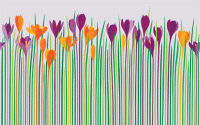Mirror, Mirror on the Wall: How Can I Be a Better Teacher Next Fall?
I love May. The weather is as close to perfect as it will be all year in most parts of the country. The songbirds have returned to sing to us. My favorite sport, baseball, is in full swing. And best of all, May is both my birthday month and my sister's. And for educators, the arrival of May means that the end of the school year is closing in.
Sure, there is a lot to do this time year, and students have started counting down the hours left before vacation -- and for many teachers, we are counting down the days. In my view, this is the best time for reflection about what we can do to make next year even better than this year. We have a lot of information available to us, and we still have access to what we learn from our students, which is not possible once they are gone for the summer. Following are some of my favorite self-reflection strategies. They are different from the traditional devices used by schools to evaluate your performance, because they are designed to give you a different type of insight -- one that can help you change.
1. Be in a Frame of Mind to Change
I need to lose weight, and I've developed a strategy to do so. I buy exercise videos, and I watch them. Sometimes I eat Ben and Jerry's ice cream while watching the videos, and think, "That's a good one," or "That one's not for me." Needless to say, this plan has a few flaws. Every reader of this post wants to change something about him- or herself and has trouble doing it. Examples abound, ranging from a desire to get better organized or spend more time with spouse, children, parents and friends, to getting in shape, reading more or solving a problem with a particular student. Very few things in life are more difficult to do than changing ourselves, even when we want to. Self-help books that purport to make us better are always among the best sellers. People who successfully change themselves are those who find a readiness within that has very little to do with will power. We change when are ready -- intellectually, emotionally and spiritually. To change the way we teach, to improve it, requires the same kind of readiness. We stop listening to all the reasons why we can't change and start believing that we can. Once you feel ready, try the following. They are fun, revealing and helpful to those who can look themselves in the mirror without defensiveness and excuses. All can be used with students of any grade, with language and modifications for those too young to write complex thought.
2. Prepare a Master List
All of the next suggestions begin with building a master list. It has four categories:
A. Major things you will definitely do
B. Minor changes you will make
C. Major things you will never do
D. Minor things you will never do
3. Student Essays
These essays can be in discussion form for the younger grades and in writing for older students. The topic is: "If you were the teacher in this class this year, what would you do the same or differently than I did? You don't need to sign your names." Explain to the students that you are serious and won't consider silly things like a rule that allows students not to come to class. (This, of course, is not appropriate for experimental schools where attendance is optional.) Ask for honesty and seriousness. Add any items to the four categories of the master list that repeat in the various essays, or any item you particularly find appealing.
4. Five-Item Lists
Hand out 5x7 note cards to your students. On one side of the card, ask them to list five things that helped them learn during the year. On the other side, they'll write five things that made it hard for them to learn. No names are required. While they are doing this, take your own card and on each side write your predictions of what you think will be your students' most common answers. Later, compare the students' set with your predictions. See how accurate you were, and find items that give you ideas on how to improve your teaching. Add these items to your master list in the appropriate categories.
5. Student Role Plays
One of my favorite forms of feedback, yet also one of the scariest, is to divide the class into small groups and give them about 20 minutes to develop a role-play of their teacher -- you -- teaching a lesson. These are usually hilarious and full of fun for the whole class. They can also be very revealing; watching them can be like watching yourself on video. "Do I really do that?" you'll wonder. As you watch, add items to the four categories on your master list.
6. Finalize Your Master List
If you have done any or all of these activities, your master list will be full of ideas for each section. Now it's time to prioritize your lists and cull them into a manageable number of items. I suggest two majors and three to five minors. That means two major items that you want to be sure you'll do again next year, two major changes from the way you taught this past year, and a few minor but important things to improve. Your final conclusions won't be like a formal school-wide evaluation process, but they will give you the chance to change. Most teachers are excited to try these techniques -- but never forget how difficult change can be.
And don't forget that it's May. I hope you love this month as much as I do.
